The Evening Moon Wades through the Water Constellations and Blue Planets, Taurus’ Horns Strikes Sparks, and Vesta is Visually Easier!

While we’re used to looking for the Lunar X that appears every few months near the first quarter phase, a group of Japanese astronomers decided to add a little LOVE to the half-illuminated moon. This image by Masaru Takeo and Junichi Watanabe was NASA’s Astronomy Picture of the Day for November 3, 2018. See if you can spot the letters in your binoculars and backyard telescopes on Monday night! Alas, the X won’t be there for this first quarter moon. Original image is here.
Hello, November Stargazers! Did you set your clocks back?
Here are your Astronomy Skylights for the week of November 3rd, 2019 by Chris Vaughan. Feel free to pass this along to your friends and send me your comments, questions, and suggested topics. I repost these emails with photos at http://astrogeo.ca/skylights/ where all the old editions will be archived. You can also follow me on Twitter as @astrogeoguy! Unless otherwise noted, all times are Eastern Time. To subscribe to these emails please click this MailChimp link.
I can bring my Digital Starlab portable inflatable planetarium to your school or other daytime or evening event. Contact me through AstroGeo.ca, and we’ll tour the Universe together!
Wow! For those of us living at mid-northern latitudes around the world, the skies are dark early now – after last night’s end to Daylight Savings Time! The moon will be perfectly placed for evening observing all week long while it wades through the water constellations passes the ice giant planets. Meanwhile, Earth’s nearest planets, Venus and Mars, will continue to improve in visibility as they increase their distances from the evening and morning sun, respectively. Here are your Skylights!
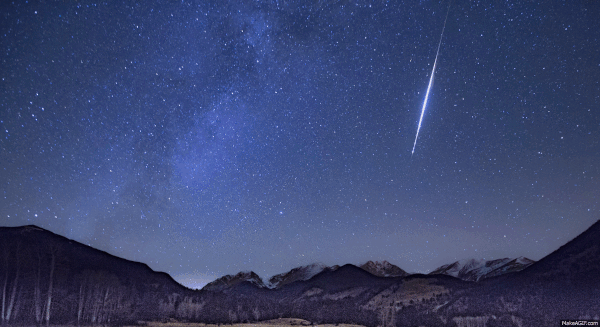
Southern Taurids Meteor Shower Peak
The annual Southern Taurids Meteor shower delivers meteors to observers worldwide from September 23rd to November 19th annually. It will peak overnight on Monday-Tuesday this week. The long-lasting, weak shower is derived from debris dropped by the passage of a periodic comet named 2P/Encke, the second such comet to be discovered, in 1786. (Periodic comets such as 1P/Halley and 67P/Churyumov-Gerasimenko orbit in our solar system on a regular schedule, never venturing too close to the sun to be disintegrated.)
The cometary debris’ larger than average grain size often produce colorful fireballs. The peak of activity, when up to five meteors per hour are predicted, will occur at about 1 am EST (or 06:00 Greenwich Mean Time). At that time, Earth will be traversing the densest part of the comet’s debris train. On the peak night, the waxing first quarter moon will set at midnight, leaving the post-midnight sky dark enough for meteor watching.
You can start watching for Northern Taurids as soon as it’s dark. The best viewing time will occur in the hours after midnight local time, when the shower’s radiant, located in western Taurus, will be highest in the sky. (When a shower’s radiant of low in the sky, the local horizon hides many of the meteors.) I wouldn’t make a special trip to see so few meteors – but keep an eye out for them if you are already outside on a clear night.
There are more meteor showers coming soon! Stay tuned!
The Moon and Planets
This is the week of the lunar month when our natural satellite will be conveniently placed in the evening sky worldwide. On Monday morning at 10:24 am EST, the moon will reach its first quarter phase. A that time, the angle between the sun, Earth, and the moon will be 90°, causing us to see the moon half-illuminated on its eastern side. (East on the moon is opposite to east on the Earth because the moon is tidally locked with Earth – so they’re mirroring one another.) The term “first quarter” refers to how much of the moon’s orbit it has completed since the previous new moon – not the way the moon appears from Earth.
At first quarter, an astronaut standing at the middle of the moon’s near-side hemisphere would be experiencing sunrise. The nearly horizontal sunlight there would cast long black shadows from any elevated surface and would render deep craters as dark pits. At the same time, if she were standing at what we see as the midway point along the moon’s illuminated edge, it would be noon for her – with the sun directly overhead.
As the moon waxes fuller in the evening sky every night (and even hour-by-hour), the “sunrise zone” is migrating west – continuously casting new strips of the moon in stark relief along the terminator, the pole-to-pole line that divides the lit and dark hemispheres. That’s the most spectacular region to look at in your binoculars and telescopes.
As for the moon’s trip through the sky this week, it will be wading through the modest water constellations! Sunday and Monday evening will find the moon among the dim stars of Capricornus (the Sea-Goat). During mid-week, the moon will cross the large constellation of Aquarius (the Water-Bearer) – passing less than a palm’s width below (or to the celestial south of) Neptune on Wednesday. Then on Friday through Sunday, the now much brighter and fuller moon will traverse the stars of Cetus (the Whale) and Pisces (the Fishes), ending up about a palm’s width to the lower right (or celestial southeast) of Uranus on Sunday night.
For those of us living at mid-northern latitudes, the end of daylight savings time means that sunset is occurring at around 5 pm local time this week. And the continuously earlier sunsets from now until the Winter Solstice on December 21 means that star parties can start in late afternoon! The Southern Hemisphere is, of course, starting to see the extra daylight we’ve lost as longer days and shorter nights.
Mercury will be lost from view this week while it swings close to the sun. But observers with special equipment can see Mercury during its solar conjunction next Monday, November 11 – when it will cross the disk of the sun for five hours! I’ll share more information about that next week.
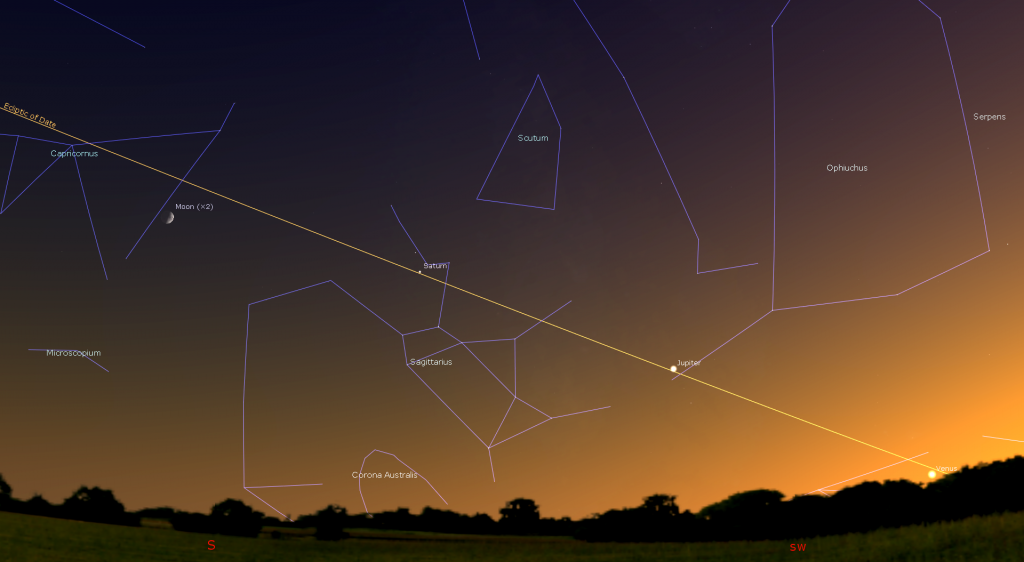
Now shining at a spectacularly bright magnitude of -3.85 and gradually ascending out of the surrounding evening twilight, Venus will be fairly easy to spot for a brief period after sunset this week, if you can find a low open horizon to the west-southwest. The planet will set at 6 pm local time.
Jupiter will be setting in the west soon after 7 pm local time this week, but the earlier-arriving sunsets of November are still giving us time to view the spectacularly bright planet, albeit through a LOT of intervening atmosphere. As the sky begins to darken this week, look for the giant planet sitting about a fist diameter above the southwestern horizon. Once it disappears in a few weeks, we’ll have to wait for Jupiter to begin a new season of viewing next February, when it will gleam in the southeastern pre-dawn sky.
Yellow-tinted Saturn, which is rather less bright than Jupiter, is still a reasonably good option for viewing in backyard telescopes. Look for it in the southwestern evening sky. At dusk, it will be located about two fist diameters above the southern horizon. It will set in the west-southwest at 9 pm local time. All year, Saturn has been located just above (or to the celestial northeast of) the stars that form the teapot-shaped constellation of Sagittarius (the Archer), and also about 2.5 fist diameters to the upper left (or celestial east) of Jupiter.
A look at Saturn is well worth dusting off your old telescope! Once the sky is dark, even a small telescope will show Saturn’s rings and several of its brighter moons, especially Titan! Because Saturn’s axis of rotation is tipped about 27° from vertical (a bit more than Earth’s axis), we can see the top surface of its rings, and its moons can arrange themselves above, below, or to either side of the planet. During this week, Titan will migrate counter-clockwise around Saturn, moving from above Saturn tonight (Sunday) to the lower left of the planet next Sunday. (Remember that your telescope will flip the view around.)
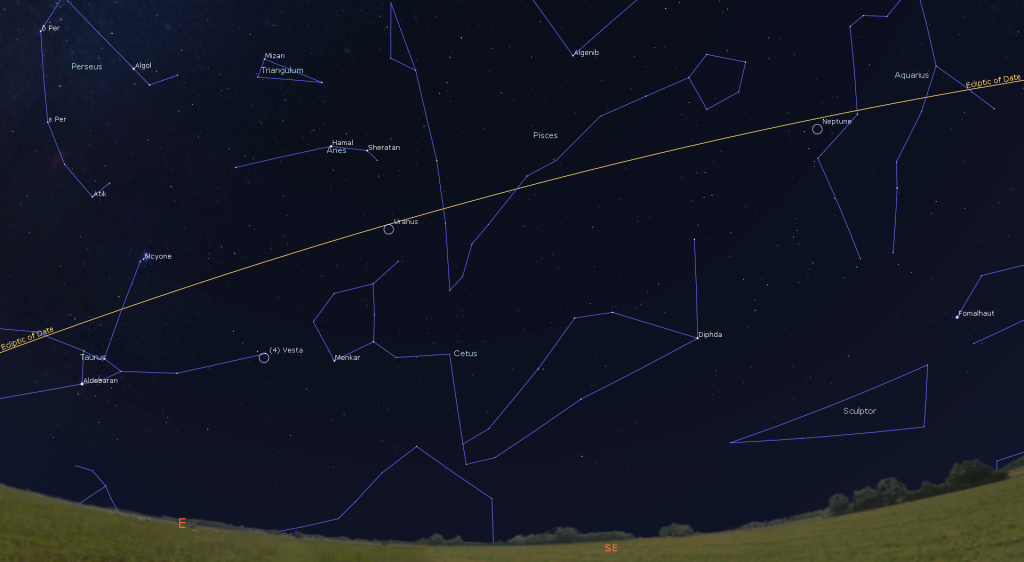
Distant and dim, blue Neptune is visible from dusk to about 2 am local time. It is among the stars of eastern Aquarius (the Water-Bearer), and sits less than a finger’s width to the right (or celestial west) of a medium-bright star named Phi (φ) Aquarii. Both blue Neptune and that golden-coloured star will appear together in the field of view of a backyard telescope at low power. The distance between the star and the planet is steadily increasing due to Neptune’s westward retrograde orbital motion. I posted a diagram of Neptune’s position compared to that star here.
Blue-green Uranus reached opposition on October 28. On that night it was closest to Earth for this year – and its minimal distance from Earth caused it to shine at a peak brightness of magnitude 5.7 and to appear slightly larger in telescopes. Visually, the slow-moving planet will look almost as good for days to come. If you can wait until after 11 pm local time to view it, when it is higher in the sky, you’ll be looking through the least amount of Earth’s disturbing atmosphere.
Right now, Uranus is sitting a palm’s width to the left (or to the celestial east) of the “V” of Pisces (the Fishes), below (or to the celestial south of) the stars of Aries (the Ram) and is just a palm’s width above the circlet of stars that form the head of Cetus (the Whale). Uranus is actually bright enough to see in binoculars and small telescopes under dark skies. You can use the three modest stars that form the top of the head of the whale (or sea-monster in some tales) to locate Uranus for the next several months – because the distant planet moves so slowly in its orbit. To help you find it, I posted a detailed star chart here.
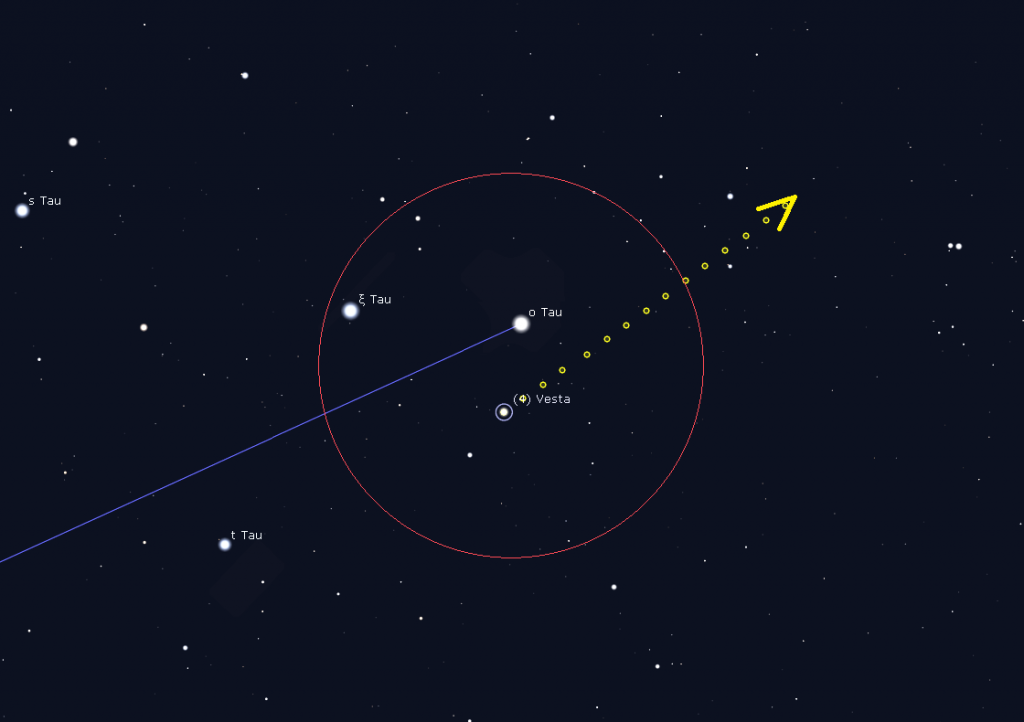
Next week the large asteroid Vesta will reach opposition and its best visibility for 2019. Meanwhile, for the next several evenings, the orbital motion of Vesta will carry it closely past the medium-bright star Omicron (o) Tauri, which marks Taurus the Bull’s hoof – setting up an easy way to find and view the magnitude 6.6 asteroid. The pair of objects will appear together in the field of view of a telescope at medium magnification. Closest approach of 20 arc-minutes (or two-thirds of the moon’s diameter) will occur on Monday, November 4. In binoculars, Vesta will be positioned below the star. Remember that most telescopes will flip that view.
Reddish Mars is becoming nicely visible now in the eastern pre-dawn sky while it continues to climb away from the pre-dawn sun. From now until October, 2020, Mars will continuously grow in brightness in the sky, and in apparent size in telescopes. In fact, the 2020 Mars opposition is a terrific excuse to get a telescope for the Holidays so you can follow the planet all spring and summer!
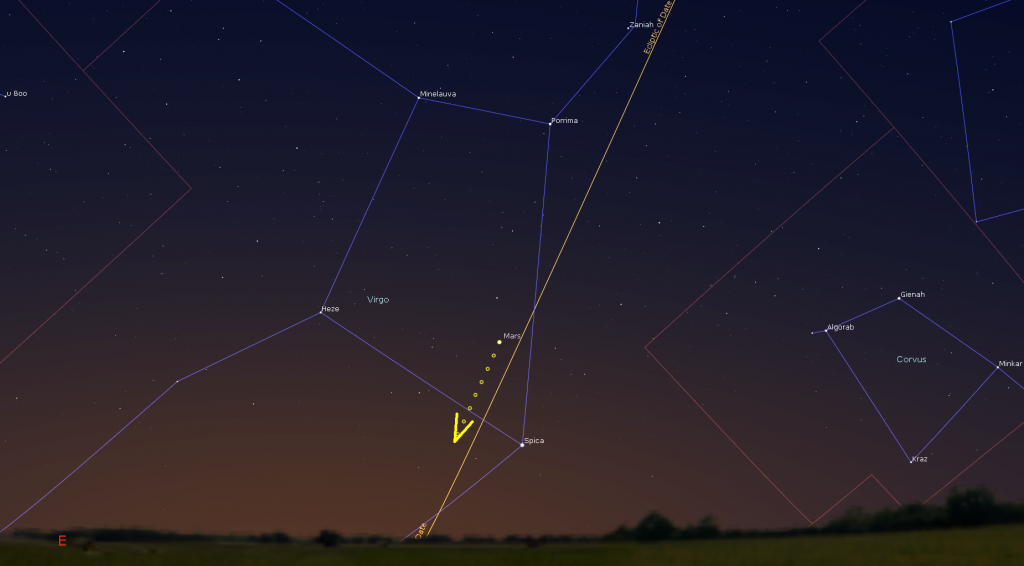
When Mars rises at about 5:05 am local time, look for bright, white Spica, the brightest star in Virgo (the Maiden), sitting just a few finger widths to Mars’ lower right (or celestial south). By next Sunday morning, Mars’ eastern orbital motion will carry the Red Planet closer to that star. The 20.8 light-minutes-distant reddish planet and the 250 light-years-distant star will appear together in the field of view of binoculars.
The Water Constellations – Capricornus the Sea-Goat
If you missed last week’s tour of Capricornus (the Sea-Goat), the second dimmest constellation of the heavens, I posted it here. We’ll tour another constellation after the bright moon leaves the evening sky.
Public Astro-Themed Events
Taking advantage of the moon and bright planets in the sky this week, the RASC Toronto Centre astronomers will hold their free monthly public City Sky Star Party in Bayview Village Park (steps from the Bayview subway station), starting around 8 pm on the first clear weeknight this week (Mon to Thu only). You don’t need to be an RASC member, or own any equipment, to join them – looks are free! Check here for details, and check the banner on their website home page or Facebook page for the GO or NO-GO decision around 5 pm each day.
Every Monday evening, York University’s Allan I. Carswell Observatory runs an online star party – broadcasting views from four telescopes/cameras, answering viewer questions, and taking requests! Details are here. On Wednesday nights they offer free public viewing through their rooftop telescopes, including their brand new 1-metre telescope! If it’s cloudy, the astronomers give tours and presentations. Registration and details are here.
On Wednesday evening, November 6 at 7 pm, the Perimeter Institute in Waterloo will present Homes Away From Home, a free public talk and webcast about Exoplanets. The speaker is Elizabeth Tasker, astrophysicist at the Japan Aerospace Exploration Agency (JAXA). Registration and details are here.
On Thursday, November 7 at 8 pm at the Bahen Centre, University of Toronto, PhD Candidate Victor Chan will present a free public talk entitled The Expanding Tension in Modern Astronomy. Telescope Observing (weather permitting) and Planetarium Shows will follow at 9 pm. Details are here.
If it’s sunny on Saturday morning, November 9 from 10 am to noon, astronomers from the RASC Toronto Centre will be setting up outside the main doors of the Ontario Science Centre for Solar Observing. Come and see the Sun in detail through special equipment designed to view it safely. This is a free event (details here), but parking and admission fees inside the Science Centre will still apply. Check the RASC Toronto Centre website or their Facebook page for the Go or No-Go notification.
Weather permitting – on Saturday evening, November 9, from 6 to 8 pm, the Ontario Science Centre will host a free public star party on their Teluscape. Parking fees may apply. Details are here.
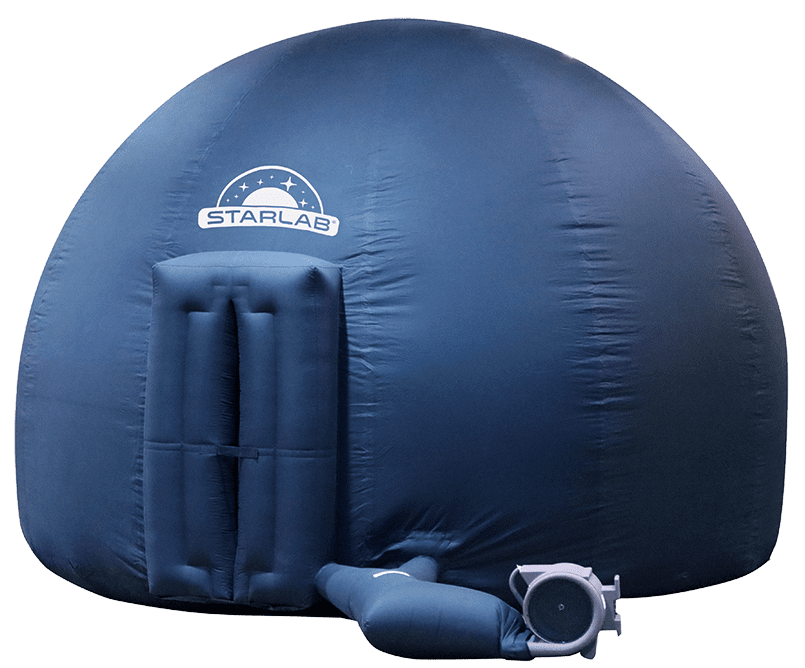
This Fall and Winter, spend a Sunday afternoon in the other dome at the David Dunlap Observatory! On Sunday afternoon, December 8, from noon to 4 pm, join me in my Starlab Digital Planetarium for an interactive journey through the Universe at DDO. We’ll tour the night sky and see close-up views of galaxies, nebulas, and star clusters, view our Solar System’s planets and alien exo-planets, land on the moon, Mars – and the Sun, travel home to Earth from the edge of the Universe, hear indigenous starlore, and watch immersive fulldome movies! Ask me your burning questions, and see the answers in a planetarium setting – or sit back and soak it all in. Sessions run continuously between noon and 4 pm. Ticket-holders may arrive any time during the program. The program is suitable for ages 3 and older, and the Starlab planetarium is wheelchair accessible. For tickets, please use this link.
Keep looking up, and enjoy the sky when you do. I love questions and requests – so, send me some!